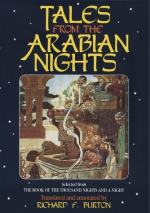[FN#124] His instinct probably told him that this opponent was a low fellow but such insults are common when “renowning it.”
[FN#125] Arab. “Dare’ " or “Dira’,” a habergeon, a coat of ring-mail, sometimes worn in pairs. During the wretched “Sudan” campaigns much naive astonishment was expressed by the English Press to hear of warriors armed cap-a-pie in this armour like medieval knights. They did not know that every great tribe has preserved, possibly from Crusading times, a number of hauberks, even to hundreds. I have heard of only one English traveller who had a mail jacket made by Wilkinson of Pall Mall, imitating in this point Napoleon iii. And (according to the Banker-poet, Rogers) the Duke of Wellington. That of Napoleon is said to have been made of platinum-wire, the work of a Pole who received his money and an order to quit Paris. The late Sir Robert Clifton (they say) tried its value with a Colt after placing it upon one of his coat-models or mannequins. It is easy to make these hauberks arrow-proof or sword-proof, even bullet-proof if Arab gunpowder be used: but against a modern rifle-cone they are worse than worthless as the fragments would be carried into the wound. The British serjeant was right in saying that he would prefer to enter battle in his shirt: and he might even doff that to advantage and return to the primitive custom of man—gymnomachy.
[FN#126] Arab. “Jamal” (by Badawin pronounced “Gamal” like the Hebrew) is the generic term for “Camel” through the Gr. æ : “Ibl” is also the camel-species but not so commonly used. “Hajin” is the dromedary (in Egypt, “Dalul” in Arabia), not the one-humped camel of the zoologist (C. dromedarius) as opposed to the two-humped (C. Bactrianus), but a running i.e. a riding camel. The feminine is Nakah for like mules females are preferred. “Bakr” (masc.) and “Bakrah” (fem.) are camel-colts. There are hosts of special names besides those which are general. Mr. Censor is singular when he states (p.40) “the male (of the camel) is much the safer animal to choose ;” and the custom of t e universal Ease disproves his assertion. Mr. McCoan ("Egypt as it is”) tells his readers that the Egyptian camel has two humps, in fact, he describes the camel as it is not.
[FN#127] So, in the Romance of Dalhamah (Zat al-Himmah, the heroine the hero Al-Gundubah ("one locust-man”) smites off the head of his mother’s servile murderer and cries, I have taken my blood-revenge upon this traitor slave’” (Lane, M. E. chaps. xx iii.)
[FN#128] This gathering all the persons upon the stage before the curtain drops is highly artistic and improbable.
[FN#129] He ought to have said his dawn prayers.
[FN#130] Here begins what I hold to be the oldest subject matter in The Nights, the apologues or fables proper; but I reserve further remarks for the Terminal Essay. Lane has most objectionably thrown this and sundry of the following stories into a note (vol. ii., pp. 53-69).




